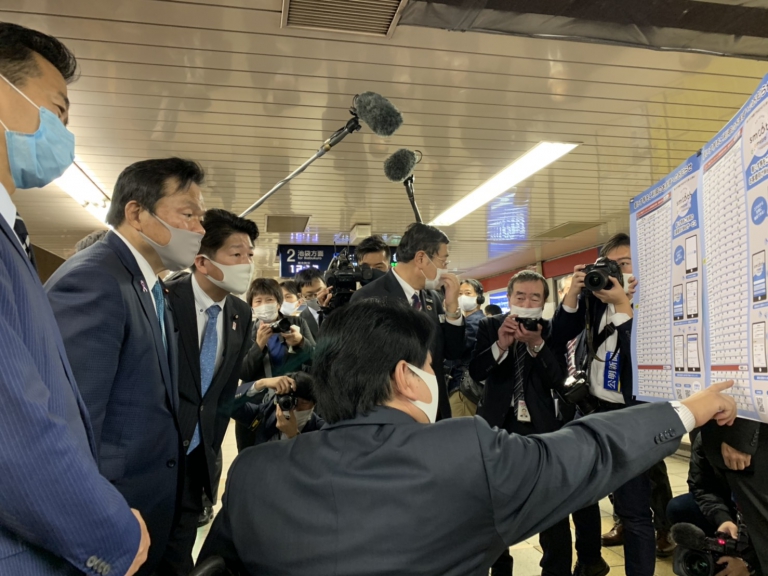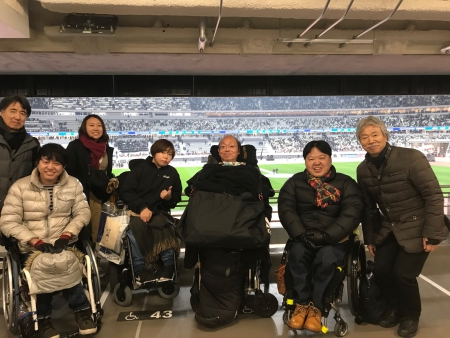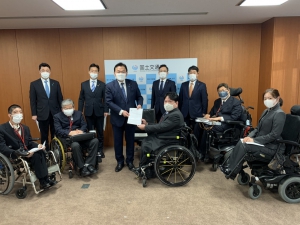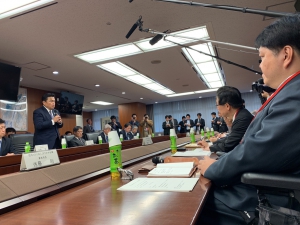Barrier-Free Subcommittee
Toward a society in which public transportation is accessible for everyone and everyone can live without barriers

The Barrier-Free Subcommittee has been working for the realization of “public transportation that everyone can use” and “a society in which everyone can be comfortably livable” since the Japan National Assembly of Disabled Peoples’ International (DPI-Japan) was established in 1986.
For people with disabilities, ensuring the right to mobility is an important issue that is indispensable for their participation in society, and although progress has been made in barrier-free public transportation and buildings compared to 30 years ago, there are still many problems such as refusal to board or restrictions on use.
Thanks to the efforts of the disabled people’s movement over the decades, it is now commonplace for elevators and slopes to be installed in stations. As a result, mobility has become much more convenient not only for people with disabilities in wheelchairs, but also for the elderly, people with baby strollers/pushchairs, people carrying suitcases, and many others.
A society that is liveable for people with disabilities can be a society that is livable for everyone.
The Barrier-Free Subcommittee has formulated the following vision for the year 2030. We will continue to actively campaign for the realization of this vision.
The vision of the DPI Barrier-Free Subcommittee
To create a society in which people with disabilities can move and use public transportation without barriers, enter stores and buildings, and enjoy culture, art, and sports by realizing their right to mobility and information, and communication.
Vision to be realized by 2030
1) Establish a legal system that promotes the right to mobility and environmental improvement for people with disabilities.
2) Make it mandatory for all buildings to be barrier-free, and promote barrier-free buildings and facilities that everyone can enter and use.
3) Make all public transportation barrier-free so that it can be used comfortably by everyone.
4) Promote the development of an environment for information and communication accessibility so that no one is left behind.
1. A legacy we can be proud to show to the world! Barrier-Free Initiatives in the Wake of the Tokyo 2020 Olympic and Paralympic Games

With the Tokyo 2020 Olympic and Paralympic Games as an opportunity, we launched the “DPI-Japan Olympic and Paralympic Project” in 2014 with the aim of developing barrier-free facilities that meet global standards.
Until a few years ago, Japan’s barrier-free maintenance standards lagged far behind the rest of the world. By reflecting the IPC Accessibility Guide, the world’s standard for barrier-free construction, in the Tokyo 2020 Accessibility Guidelines, the standard for construction of facilities for the Tokyo Games, we have worked to develop a world-class venue for the Games and further promote barrier-free transportation.
In particular, we lobbied for the construction of the New National Stadium from the planning stage, and participated in the Universal Design Workshop with diverse stakeholders to realize Japan’s first stadium that meets global standards.

By preparing specific proposals on what kind of improvements we wanted to see, and by continuing to lobby the national government, Diet members, and related organizations, we were able to achieve significant results.
We will not stop with the Tokyo Games, but will continue to spread the Tokyo 2020 Accessibility Guidelines, a global standard for barrier-free accessibility maintenance, throughout Japan for the next generation.
We have published a number of recommendations for the 2020 Olympics and Paralympics:
- The First Opinion (Recommendations for Universal Design of Athletic Facilities)
- The Second Opinion (Recommendations on Access)
- The Third Opinion (Recommendations on accommodation, signage, hospitality, etc.)
Other information
▽ IPC Accessibility Guide(PDF) Japan Paralympic Committee website
▽ Tokyo2020 Accessibility Guidelines (Tokyo 2020 Organizing Committee website)
▽ Universal Design 2020 Action Plan (Prime Minister’s Office website)
2. Revision of the Barrier-Free Act and various standards

DPI Japan has conducted annual transportation accessibility actions since the 1980s, calling for the formulation of barrier-free laws. As a result of these actions, the Transportation Barrier-Free Act was enacted in 2000, and from this point on, barrier-free development in Japan has progressed.
In 2006, the law was merged with the Heart Building Law to become the Barrier-Free Law, and standards for the development of barrier-free buildings were formulated. However, the law was not amended for many years after that, and while the barrier-free construction of railroads and buses in urban areas has progressed, the construction of buildings and rural areas has not.

The Tokyo Olympics and Paralympics provided the impetus for barrier-free development, which led to the revision of the Barrier-Free Act in 2018 and 2020.
Along with the revision of the law, various standards have been reviewed, and significant results have been achieved, such as barrier-free measures for Shinkansen (high speed /bullet trains), elimination of steps and gaps on platforms, and the establishment of barrier-free guidelines for small-scale stores, all of which have been completely unsuccessful in the past.
With the aim of creating a truly universal society and improving accessibility as required by the Convention on the Rights of Persons with Disabilities (CRPD), we will continue our efforts to amend laws and review and establish various standards.
Other references (information on disability-related policies and data can be seen here:
▽ Ministry of Land, Infrastructure, Transport and Tourism, Barrier-Free and Universal Design)
現在位置:ホーム > Our Activity > Barrier-Free Subcommittee
